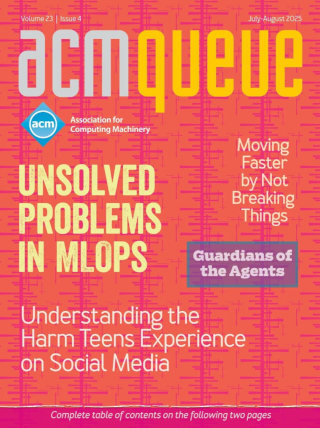
Persistence Programming:
Are we doing this right?
A few years ago, my team was working on a commercial Java development project for Enhanced 911 (E911) emergency call centers. We were frustrated by trying to meet the data-storage requirements of this project using the traditional model of Java over an SQL database. After some reflection about the particular requirements (and nonrequirements) of the project, we took a deep breath and decided to create our own custom persistence layer from scratch.
Distributed Latency Profiling through Critical Path Tracing:
CPT can provide actionable and precise latency analysis.
Low latency is an important feature for many Google applications such as Search, and latency-analysis tools play a critical role in sustaining low latency at scale. For complex distributed systems that include services that constantly evolve in functionality and data, keeping overall latency to a minimum is a challenging task. In large, real-world distributed systems, existing tools such as RPC telemetry, CPU profiling, and distributed tracing are valuable to understand the subcomponents of the overall system, but are insufficient to perform end-to-end latency analyses in practice. Scalable and accurate fine-grain tracing has made Critical Path Tracing the standard approach for distributed latency analysis for many Google applications, including Google Search.
Middleware 101:
What to know now and for the future
Whether segregating a sophisticated software component into smaller services, transferring data between computers, or creating a general gateway for seamless communication, you can rely on middleware to achieve communication between different devices, applications, and software layers. Following the increasing agile movement, the tech industry has adopted the use of fast waterfall models to create stacks of layers for each structural need, including integration, communication, data, and security. Given this scope, emphasis must now be on endpoint connection and agile development. This means that middleware should not serve solely as an object-oriented solution to execute simple request-response commands. Middleware can incorporate pull-push events and streams via multiple gateways by combining microservices architectures to develop a holistic decentralized ecosystem.
Autonomous Computing:
We frequently compute across autonomous boundaries but the implications of the patterns to ensure independence are rarely discussed.
Autonomous computing is a pattern for business work using collaborations to connect fiefdoms and their emissaries. This pattern, based on paper forms, has been used for centuries. Here, we explain fiefdoms, collaborations, and emissaries. We examine how emissaries work outside the autonomous boundary and are convenient while remaining an outsider. And we examine how work across different fiefdoms can be initiated, run for long periods of time, and eventually be completed.
The Planning and Care of Data:
Rearranging buckets for no good reason
Questions such as, "How do we secure this data?" work only if you ask them at the start, and not when some lawyers or government officials are sitting in a conference room, rooting through your data and logs, and making threatening noises under their breath. All the things we care about with our data require forethought, but it seems in our rush to create "stakeholder value" we are willing to sacrifice these important attributes and just act like data gourmands, until, like Mr. Creosote in Monty Python's The Meaning of Life, we explode, scattering half-digested data all over the dining room.



